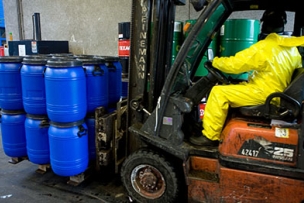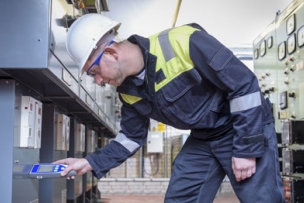Combustible dust may be one of the most invisible and under regulated areas of general industry. Yet its presence in the workplace can be closely monitored, and explosions are preventable. Here’s what to look out for and what can be done.
August 2016: 75 people are killed and 185 others are injured in an explosion at a metal products factory in China’s eastern Jiangsu Province.
May 2017: Five workers are killed and more than a dozen others are injured from an explosion at the Didion Milling Plant in Cambria, Wisconsin.
Despite occurring more than a year apart at opposite ends of the globe, the blasts that rocked both Jiangsu and Cambria have a single commonality: combustible dust.
For the Didion Milling Plant, it wasn’t the first time the facility’s safety was called into question––it was cited by the Occupational Safety and Health Administration in 2011 for failing to provide equipment to employees that protects against explosions, according to the Associated Press. The company settled the dispute by paying a $3,465 fine, but poor building maintenance ultimately resurfaced and caused the deadly explosion to occur.
As OSHA spotlights, there have been more than 500 explosions, 200 deaths and nearly 700 injuries related to combustible dust over the past 35 years in facilities that handle grain. However, combustible dust is a serious hazard for workplaces that span industries, geographic location, building type and product type.
Between 1980 and 2005, the U.S. Chemical Safety and Hazard Investigation Board—an independent agency similar to the National Transportation Safety Board—identified nearly 300 combustible dust incidents that killed 119 workers and injured 718, according to its 2006 report where it wrote:
“These findings illustrate the seriousness of the combustible dust hazard in U.S. workplaces, yet no comprehensive federal Occupational Safety and Health Administration (OSHA) standard exists to control the risk of dust explosions in general industry. Although OSHA has cited employers for failing to address combustible dust hazards, almost all those citations have followed an explosion, and so did not have a preventive focus.”
Of course, that doesn’t mean you can’t equip yourself and your team with the proper knowledge and skill set to help prevent deadly combustible dust explosions. Here, we outline what exactly combustible dust is, how it forms, and what you can do to protect your associates from harm.
What Is Combustible Dust?
Although combustible dust can be (and usually is) catastrophic and cause injuries, that danger is not always apparent. OSHA defines combustible dust as “fine particles that present an explosion hazard when suspended in air under certain conditions. A dust explosion can cause catastrophic loss of life, injuries and destruction of buildings.”
Some of the most common combustible-dust materials range from agricultural products like egg whites and powdered milk to metals like aluminum and bronze to coal and sulfur to rubber, wood, textiles and plastics, outlines OSHA. That being said, oftentimes employers and associates aren’t aware that the hazard existed in the first place.
Of course, egg whites alone won’t cause a deadly explosion. As the U.S. Chemical Safety and Hazard Investigation Board finds, a dust fire will occur when any of the three elements of a classic “fire triangle” are exposed to heat (fuel, ignition and oxygen). A dust explosion, however, is based off the “Dust Explosion Pentagon” (fuel, ignition, dispersion, oxygen and confinement). When any two of these elements are activated in the presence of dust, an explosion will occur.
But no two combustion cocktails will be alike, as no two factories, products or manufacturing processes are the same.
“Dust explosions are readily preventable with engineering controls, ventilation, training and other measures. The voluntary, industry-supported national fire codes have urged these measures for decades, and they now must be codified and enforced through federal regulations.”
Why Combustible Dust Matters for All Shops
As many products are capable of creating and accumulating dust, no factory, shop or plant is immune to the danger. But companies working in food production, synthetic manufacturing, woodworking, metal processing and recycling are at the most risk, according to EHS Today.
The dust is created when products and materials are transported, handled, processed, adjusted and reshaped by cutting, crushing and mixing––tasks that may account for the bulk of the work employees execute on a daily basis. In other words, no workplace is completely safe from combustion.
OSHA Regulation vs. Self-Regulation: How to Shape Your Safety Policies Surrounding Combustible Dust
OSHA only has specific regulations in place to limit the combustible dust in the grain industry, but it does have standards that should be followed by all. Take note that 25 states have OSHA-approved state plans.
OSHA recommends a series of steps and tactics to ensure your workplace is free from dangers associated with combustible dust. Ultimately, this all starts with the dust itself––implementing regular dust inspecting, testing, housekeeping and other control programs will be your best bet. Additionally, OSHA recommends the following in regard to keeping dust under control:
- Using proper dust collection systems and filters
- Minimizing dust escape from equipment or ventilation
- Opting for surfaces that minimize dust accumulation and are easy to clean
- Providing access to areas that might accumulate dust (but possibly not foot traffic)
- Using cleaning methods and vacuums that do not create dust themselves and are approved for collecting dust
- Ensuring relief valves are far from dust deposits
In addition to frequent inspection and cleaning, OSHA stresses that employers select electrical equipment and wiring methods that don’t leave dangerous electrical or toxic elements exposed and in the presence of dust. OSHA also recommends using separator devices to remove foreign materials that might ignite at a moment’s notice from friction.
Despite any preventive measures your team might take in combating combustion, there is a chance an explosion will occur––and you should be accounting for that possibility, too. In that instance, OSHA recommends your facility is equipped with specialized fire suppression systems and that hazardous materials are segregated from workplaces with high traffic or areas with other combustible materials.
Despite the preventive measures you can (and should take), the need for OSHA to keep pace with the eminent danger combustible dust presents remains apparent.
“Dust explosions are readily preventable with engineering controls, ventilation, training and other measures,” explains Rafael Moure-Eraso, the former chairman of the United States Chemical Safety Board, in an op-ed piece for The New York Times. “The voluntary, industry-supported national fire codes have urged these measures for decades, and they now must be codified and enforced through federal regulations.”
For more information on combustible dust, review OSHA’s guidance and OSHA’s references for all consensus standards from the National Fire Protection Association, FM Global and the International Code Council—as well as the general duty clause.
How do you equip your facility to prevent combustible dust explosions? Let us know in the comment section below.




Talk to Us!
Leave a reply
Your email address will not be published. Required fields are marked *